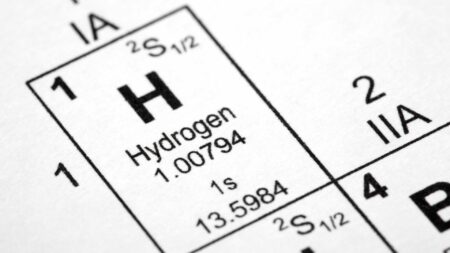Scientists have discovered a novel chemical mechanism for converting a foul-smelling, hazardous gas into a clean-burning fuel.
The method, which was recently published in the American Chemical Society journal ACS Sustainable Chemical Engineering, converts hydrogen sulfide, also known as “sewer gas,” into hydrogen fuel. Hydrogen sulfide is an important by-product of industrial activity such as refining oil and gas, making paper, and mining, and is discharged from manure piles and sewer pipes.
The procedure described in this work uses a low-cost material—iron sulfide with a trace quantity of molybdenum as an additive—and requires little energy.
Hydrogen sulfide, in addition to stinking like rotten eggs, is extremely hazardous, corroding pipes and endangering the health of those who come into contact with it.
Lang Qin, a coauthor on the paper and a research associate in chemical and biomolecular engineering at The Ohio State University, said, “Hydrogen sulfide is one of the most damaging gases in industry and to the environment.” “And, because the gas is so dangerous, a lot of scientists are working to convert hydrogen sulfide into something less dangerous, preferably valuable.”
The research builds on prior work by the same research group, which used a mechanism called chemical looping to burn fuels without direct contact between air and fuel in high-pressure reactors. To transform fossil fuels into energy without putting carbon dioxide into the atmosphere, the scientists first utilized chemical looping on coal and shale gas. To break down the fossil fuels, the first technique used iron oxide.
The principle was eventually applied to hydrogen sulfide, and the SULGEN process, which converts hydrogen sulfide to hydrogen, was developed. According to Qin, the researchers discovered that the pure chemical, iron sulfide, didn’t work well at the vast quantities required for commercial use. The researchers have been looking for new low-cost compounds that could promote the transition in larger amounts. This research suggests that adding a trace quantity of molybdenum to iron sulfide could be a viable alternative.
Because the material is very inexpensive and simple to obtain, it is an appealing option for larger-scale operations.
Transforming this toxic gas into hydrogen fuel creates an alternative oil and gas, which are major contributors to climate change, the researchers said.
“It is too soon to tell if our research can replace any of the hydrogen fuel production technologies that are out there,” said Kalyani Jangam, lead author of the study and a graduate student in Ohio State’s Clean Energy Research Laboratory. “But what we are doing is adjusting this decomposition process and making a valuable product from that.”
For this most recent study, the researchers found that molybdenum improves the breakdown of hydrogen sulfide, splitting it into two parts—hydrogen fuel and sulfur.
This work is early in the scientific process—the researchers showed that the process worked in the lab; tests at the industrial level are forthcoming.
“The big picture is we want to solve the harmful gas issue, and we thought that our chemical looping process would allow that,” Qin said. “And here, we have found a way to do it in the lab that creates this value-added hydrogen fuel.”
The senior author on this paper is Liang-Shih Fan, professor of chemical and biomolecular engineering at Ohio State. Yu-Yen Chen, a former doctoral student in Fan’s laboratory, also contributed.








